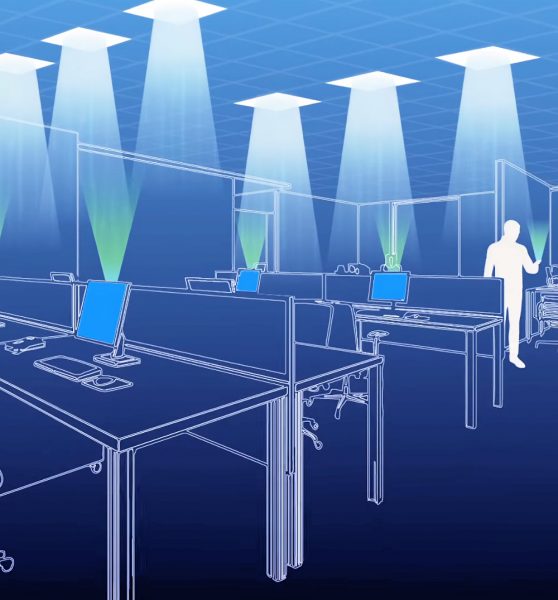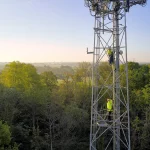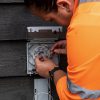pureLiFi Get £10m to Develop Wi-Fi Style Visible Light Networks

The Scottish National Investment Bank has awarded £10m to help Edinburgh-based pureLiFi, which has spent years developing a new Visible Light Communication (VLC) based networking method called LiFi, to support a global rollout of their revolutionary technology.
VLC networks, at least the newer type that pureLiFi is talking about, essentially turn Light-Emitting Diode (LED) based light bulbs into a sophisticated wireless data network (similar to how Infrared links work). This is achieved by turning the bulb(s) on and off many times a second (most of them already do this to save power) and, by altering the length of these “flickers“, as well as other properties of the light, you can introduce a digital communication (e.g. think of Morse Code with a torch).
However, the technology has often struggled to take off, which is partly due to the fact that the market has been dominated by proprietary standards. But in 2019 an international group of companies from across the Wi-Fi ecosystem (Intel, TI, Quantenna, Cisco and HPE etc.) came together to develop a proper standard based on Wi-Fi (IEEE 802.11). The new LiFi standard – called 802.11bb – is currently in Draft 2.0 and nearing completion.
Advertisement
Suffice to say, LiFi may have had a VERY.. slow start, but the bank’s investment suggest that it might finally be about to get off the ground. PureLiFi will use the extra funding to further develop new LiFi technologies, while opening up additional markets in more consumer-friendly areas, such as mobile phones, tablets, wearables and other connected devices.
Alistair Banham, pureLiFi CEO, said:
“The Bank’s investment will help us achieve our vision to connect everyone and everything with LiFi. We introduced our technology to the world from Scotland and it is important for us to grow our company and ecosystem from here.
Our vision is for Scotland to be a recognised centre of excellence for LiFi. In the future customers from around the world will come to us for our innovative technology and leverage the wider photonics ecosystem that already exists here in Scotland.”
At present most of the early indoor VLC networks have been aimed at office environments and tended to deliver speeds of around 40Mbps to 250Mbps (depending upon the setup and number of bulbs etc.), although the technology has since pushed into multi-gigabit territory. But it remains to be seen how the latter translates into the real-world.
The clear advantage of VLC is that it could remove some of the capacity strain from existing wireless networks and would be more secure (you can still intercept the signal, but it’s trickier than WiFi). On the other hand, VLC is currently more of a complement than a replacement for WiFi, particularly as spreading the service around your home would be difficult / expensive without replacing the bulbs in every room.
The other question mark is over how much extra electricity such bulbs would consume, as well as whether consumers might find themselves in the odd situation of needing to leave their lights switched-on during the daytime in order to benefit (note: they can be dimmed down to c.10% brightness and still work).
Advertisement
Nevertheless, it’s an interesting technology, albeit one that may struggle to take off until there are some real and affordable consumer products on the market. Even then, it faces an uphill struggle against the established giant that is modern WiFi.
Mark is a professional technology writer, IT consultant and computer engineer from Dorset (England), he also founded ISPreview in 1999 and enjoys analysing the latest telecoms and broadband developments. Find me on X (Twitter), Mastodon, Facebook, BlueSky, Threads.net and Linkedin.
« Virtual1 and ITS Technology Partnership to Combine UK Full Fibre Networks






















































As is often the case in technological breakthroughs, its when you think about the basic principles involved with the technology in question is when you realise how obvious it is in the first place. Kudos to the team who worked through this new LiFi tech and I wish them all the best in tackling the problems of how to bring this to mass market. Great story!
This is nothing new, we’ve been sending data using light for a long time, the simplest being the humble remote control. At one time many years ago PCs and laptops used infra red for syncing with some devices. The issues are interference, as there is a lot of visible light around, and the main barrier is line of sight is required and close proximity. Light is best used in fibre optic cable where it can be guided and shielded. Also what happens when you have plenty of daylight and don’t need the lights on? Do you have to put them on anyway just to get some Internet and wasted loads of electricity.
So far LiFi has been over 10 years in the making, if it was feasable and better than Wi-Fi we’d have products by now.
I heard about this a few years ago & then nothing. This would be really useful, in places like offices or hard to reach pieces in the home.
@Michael It wouldn’t help hard to reach places because you would have to run a network cable to the kit that interfaces with the lights and fittings in that place, if you are going to this trouble then you might as well add another access point on the end of the Ethernet cable and save a load of hassle as the light fittings would need to be all new and may not work very well as replacements in the home (style wise or need different fixings).
Basically all the things it claims to do is already done by Wi-Fi, which we’ve been enjoying for years and years already. There is little reason that a single Wi-Fi access point can not cover a whole house when installed correctly. Installing a proper access point centrally in the home upstairs (i.e run Ethernet to the loft and use PoE) will easily cover most properties, whereas a router sat downstairs next to a wall is seldom providing the best coverage, for a start half the signal is probably ending up next door or adsorbed by the brick wall its against. The effort of installing LiFi in the home would be better diverted to skipping the light part of it and adding a ceiling mounted access point.